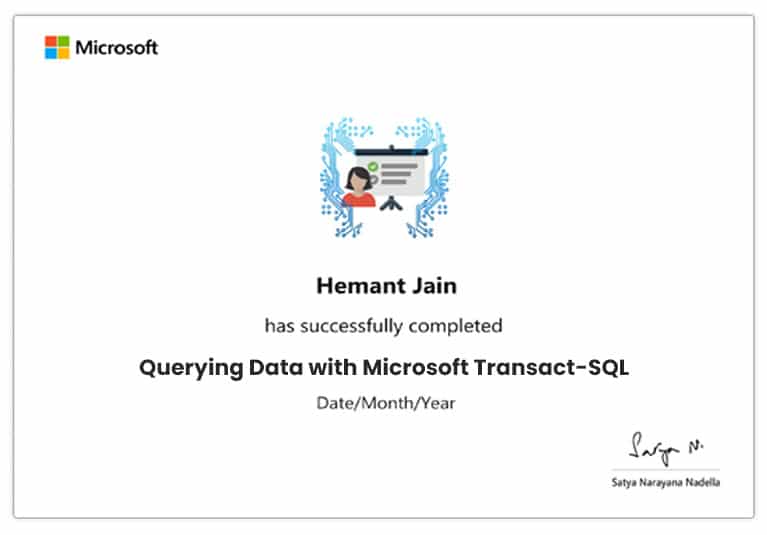Your cart is currently empty.
The Microsoft Business Intelligence certification training helps you master MSBI tools like SSIS, SSRS, and SSAS using SQL Server. This MSBI training course will also help you clear the MCSE: Business Intelligence Certification. Learn data integration and the creation of reports, dashboards, and cubes for faster reports generation.

Watch
Course PreviewThis MSBI certification training provides you with all skills needed to work with the Microsoft BI stack. Master SQL Server analysis, integration, Data Warehousing, ETL Solutions, Connecting Managers, etc. Receive official course material issued by Microsoft for Analyzing Data with SQL Server Reporting Services.
Anybody can take up this online training course and get trained in MSBI.
Today, the demand for SQL Server Business Intelligence professionals is increasing, and there is a real need for expertise in SSAS, SSIS and SSRS. Hence, with this tutorial you can take up highly coveted Microsoft BI jobs and pass the MCSE: Business Intelligence Certification for a great future.
Talk To Us
We are happy to help you 24/7
ETL
OLE DB
ADO.net
OLEDB Command Transformation
Slowly Changing Dimensions (SCDs)
Fuzzy matching
SSRS
Tablix
Matrix
Data Modeling
Data Cleaning
Data Analysis
Data Representation
Data Transformation
₹10,032
Contact Us
Introduction to Business Intelligence, understanding the concept of Data Modeling, Data Cleaning, learning about Data Analysis, Data Representation, Data Transformation.
Introduction to ETL, the various steps involved Extract, Transform, Load, using a user’s email ID to read a flat file, extracting the User ID from email ID, loading the data into a database table.
Introduction to Connection Managers – logical representation of a connection, the various types of Connection Managers – Flat file, database, understanding how to load faster with OLE DB, comparing the performance of OLE DB and ADO.net, learning about Bulk Insert, working with Excel Connection Managers and identifying the problems.
Learning what is Data Transformation, converting data from one format to another, understanding the concepts of Character Map, Data Column and Copy Column Transformation, import and export column transformation, script and OLEDB Command Transformation, understanding row sampling, aggregate and sort transformation, percentage and row sampling.
Understanding Pivot and UnPivot Transformation, understanding Audit and Row Count Transformation, working with Split and Join Transformation, studying Lookup and Cache Transformation, Integrating with Azure Analysis Services, elastic nature of MSBI to integrate with the Azure cloud service, scale out deployment option for MSBI, working with cloud-borne data sources and query analysis. Scaling out the SSIS package, deploying for tighter windows, working with larger amount of data sources, SQL Server vNext for enhancing SQL Server features, more choice of development languages and data types both on-premise and in the cloud.
Understanding data that slowly changes over time, learning the process of how new data is written over old data, best practices.Detail explanation of three types of SCDs –Type1, Type2 and Type3, and their differences.
Understanding how Fuzzy Lookup Transformation varies from Lookup Transformation, the concept of Fuzzy matching
Learning about error rows configuration, package logging, defining package configuration, understanding constraints and event handlers.
Get introduced to the SSRS Architecture, components of SSRS Report Building tool, learning about the data flow in different components.
Understanding the concepts of Matrix and Tablix, working with Text Box, learning about formatting, row/column grouping, understanding sorting, formatting, concepts of Header, Footer, Totals, Subtotals and Page Breaks.
Learning about Parameters, filter and visibility expression, understanding drill-through and drill-down, defining variables, custom code.
Introduction to various aspects of Bar Chart, Line Chart, Combination Chart, Shape Chart, Sub Reports,Integration of Power Query and M language with SSRS, working with additional data sources in MSBI, rich transformation capabilities addition to MSBI, reusing M functions build for PBIX in SSRS.
Learn how to build a Dashboard with Sparklines, Data Bars, Map Charts, Gauge Charts and drilling into reports, the basics of ad hoc reporting.
Data Bar, Sparkline, Indicator, Gauge Chart, Map Chart, Report Drilling, What is Ad hoc reporting?
Understanding Report Cache, Authorization, Authentication and Report Snapshot, learning about Subscriptions and Site Security.
Understanding the concept of multidimensional analysis, understanding SSAS Architecture and benefits, learn what is Cube, working with Tables and OLAP databases, understanding the concept of Data Sources, working with Dimension Wizard, understanding Dimension Structure, Attribute Relationships, flexible and rigid relationship.
Learning about Process Dimension, the Process database, creation of Cube, understanding Cube Structure, Cube browsing, defining the various categories, Product Key and Customer Key, Column Naming, processing and deploying a Cube, Report creation with a Cube.
Hands-on Exercise – Create a Cube and name various columns Deploy a cube after applying keys and other rules Create reports with a cube
Understanding Data Dimensions and its importance, the various relationships, regular, referenced, many to many, fact, working on Data Partitions, and Data Aggregations.
Learning about SSAS Cube, the various types of Cubes, the scope of Cube and comparison with Data Warehouse.
The various operations on Cube, the limitations of OLAP Cubes, the architecture of in-memory analytics and its advantages.
Deploying cube with existing data warehouse capabilities to get self-service business intelligence, understanding how in-memory analytics works.
Hands-on Exercise – Deploy cube to get self-service business intelligence
Logical model of the schema used by the Cube, components of Cube, understanding Named Queries and Relationships.
An overview of the Dimensions concept, describing the Attributes and Attributes Hierarchies, understanding Key/Value Pairs, Metadata Reload, logical keys and role-based dimensions.
Hands-on Exercise – Create role based dimensions, Use Attributes Hierarchies
Understanding the Measure of Cube, analyzing the Measure, exploring the relationship between Measure and Measure Group, Cube features and Dimension usage.
Working with Cube Measures, deploying analytics, understanding the Key Performance Indicators, deploying actions and drill-through actions on data, working on data partitions, aggregations, translations and perspectives.
Hands-on Exercise – Work with Cube Measures, Deploy analytics, Deploy actions and drill-through actions on data, Make data partitions
Understanding Multidimensional Expressions language, working with MDX queries for data retrieval, working with Clause, Set, Tuple, Filter condition in MDX.
Hands-on Exercise – Apply Clause, Set and filter condition in MDX query to retrieve data
Learning about MDX hierarchies, the functions used in MDX, Ancestor, Ascendant and Descendant function, performing data ordering
Hands-on Exercise – Create MDX hierarchies, Perform data ordering in ascending order, in descending order
Designing and publishing a tabular data model, Designing measures relationships, hierarchies, partitions, perspectives, and calculated columns
Hands-on Exercise – Design and publish a tabular data model, Design measures relationships, hierarchies, partitions, perspectives, and calculated columns
Configuring and maintaining SQL Server Analysis Services (SSAS), Non-Union Memory Architecture (NUMA), Monitoring and optimizing performance, SSAS Tabular model with vNext, Excel portability, importing model from Power BI Desktop, importing a Power Pivot model, bidirectional cross-filtering relationship in MSBI.
Hands-on Exercise – Configure and maintain SQL Server Analysis Services (SSAS), Monitor and optimize performance
Analyzing Data with SQL Server Reporting Services
MSBI Projects
This course is designed for clearing the MCSE: Business Intelligence Certification exam. You will also receive the course completion certificate by Microsoft for Administering Microsoft Azure SQL Solutions after completing module on MS Learn.
As part of this training, you will be working on real-time projects and assignments that have immense implications in the real-world industry scenarios, thus helping you fast-track your career effortlessly.
At the end of this training program, there will be quizzes that perfectly reflect the type of questions asked in the certification exam and help you score better.
Intellipaat Course Completion Certificate will be awarded upon the completion of the project work (after the expert review) and upon scoring at least 60% marks in the quiz. Intellipaat certification is well recognized in top MNCs like Ericsson, Cisco, Cognizant, Sony, Wipro, Standard Chartered, TCS, Genpact, Tata Communication, etc.
Land Your Dream Job Like Our Alumni

This training provides you all skills needed to work with the Microsoft Business Intelligence stack. MSBI is a powerful suite of tools offering powerful data mining queries and BI capabilities through Visual Studio deployment with SQL Server. This entire course content is in line with the requirements for clearing the MCSE: Business Intelligence Certification exam.
You will be working on real-time MSBI projects and step-by-step assignments that have high relevance in the corporate world, and the course curriculum is designed by industry experts. Upon the completion of the training course, you can apply for some of the best jobs in top MNCs around the world at top salaries. Intellipaat offers lifetime access to videos, course materials, 24/7 support, and course material upgrading to the latest version at no extra fee. Hence, it is clearly a one-time investment.
Intellipaat offer certification training on Business Intelligence courses such as Power BI, Business Intelligence Masters, Tableau, ETL, Informatica, Cognos, Qlikview, SSIS, SSRS, MicroStrategy, SSAS, Data Warehousing, OBIEE, Oracle Hyperion, IBM DataStage, Jaspersoft, Pentaho, Tibco Spotfire, Talend, etc.
Intellipaat has plenty of free learning materials to help you understand the basics of MSBI such as: What is MSBI, MSBI Tutorial, and MSBI Interview Questions.
3 technical 1:1 sessions per month will be allowed.
 Click to Zoom
Click to Zoom